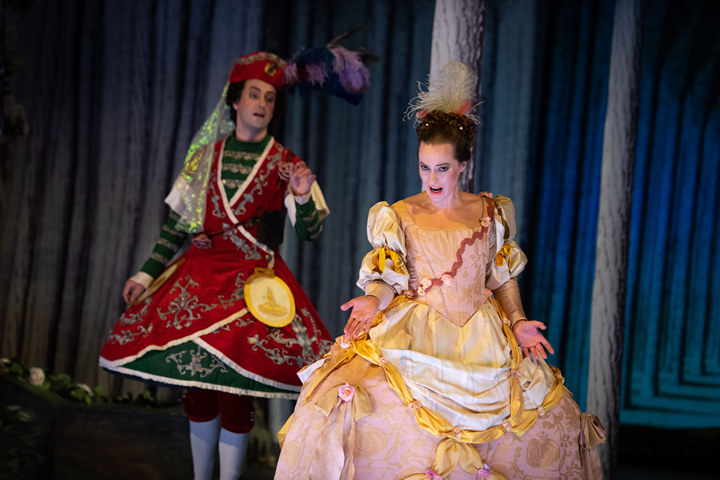| Opera Reviews | 7 May 2024 |
Bernasconi's L'Huomo offers musical and theatrical delightsby Sandra Bowdler |
|
Bernasconi: L’Huomo |
|
 |
|
|
A baroque production of an obscure opera in an appropriate historical setting offered musical and theatrical delights for the connoisseur of such things. The setting: the Palace Theatre in the New Palace, built for Frederick the Great (Friedrich II of Prussia) in the 1860s, in full-blown baroque/rococo style. As well as his Hohenzollern heritage, Frederick was also the grandson of George I of England. His sister, Wilhelmine, married (not entirely happily) the Margrave of Bayreuth, and, as a great patron the arts, established a theatre there, the Margravial Opera House. The libretto for L’Huomo, designated a “festa teatrale”, was written by Wilhelmine, with music by Andrea Bernasconi, for a performance in Bayreuth, to mark the visit of Frederick to his sister in 1754, the last time they would meet. The present production was appropriately debuted at the Margravial theatre in Bayeuth earlier this year, and comes just as fittingly to Potsdam. Originally in one act, it was performed here in two parts. The first libretto by Wilhelmine was in French, then rendered into Italian by Luigi Maria Stampiglia, son of the more famous librettist Silvio Stampiglia. The music is largely by Bernasconi, but includes some additional material by Adolph Hasse and Wilhelmine herself. This production has been developed in association with the University of Bayreuth in connection with a new critical edition of the work This has been brought to the stage with a cast of talented young singers, conductor Oberlinger and her Baroque orchestra Ensemble 1700, a troupe of Baroque dancers and an eighteenth century setting (director Nils Niemann) and costumes (Johannes Ritter). A modern touch is provided by a back projected video, featuring a night sky, a view of the moon which becomes a skull, and classical landscapes. The singers used a form of Baroque Gest thus generating an integrated form of stagecraft consistent with the music (for once, one cannot resist adding). Lacking an overture, the performance opened with a fanfare for brass and timpani, with the curtains drawn back to reveal the sleeping figures of Animia and Anemone. The first singer was soprano Francesca Benitez as “Buon Genio” – a sort of guiding spirit who appears at the beginning and end – who delivered an impressive aria with a rich flexible voice, with stunning cadenzas at the end of the A section, B section and da capo, garnering loud applause. The character, or embodied quality, of Negiorea (“reason”, die Vernunft), is described as the daughter of the good spirit, and was beautifully sung by mezzo Alice Lackner, with an impressive messa di voce on the first repeat of her first aria, and amazing cadenzas in all her arias. Once awakened, the vocal contributions of the central pair were also riveting. Maria Ladurner sang Animia with a precise, flexible high soprano, with her aria “Fuggi” (Bernasconi) after not succumbing to Amor’s temptations an absolute highlight, with sustained coloratura in a high tessitura. Anemone was sung by sopranista Philipp Mathman in a voice ranging from soprano to tenor; if he needed to swoop up to some of the higher notes, he certainly got there and managed to sustain them with tonal purity, and if some of his lower notes lacked the same power, he certainly had them, and managed to go up and down the scale without audible gear changes. Tenor Simon Bode represented two Amors, one reasonable, the other fickle; he sang with a clear ringing tenor and turned in an entertaining performance. Florian Götz was the bad spirit, with a lovely bronze bass tone. The smaller roles of Volusia and Incosia were well sung by sopranos Anna Herbst and Johanna Rosa Falkinger. One of the delights of this production was that the singers were allowed to sing, without distracting stage business going on around them at the same time. The performance was very warmly received. |
|
Photo © Stefan Gloede / Musikfestspiele Potsdam Sanssouci |
|







